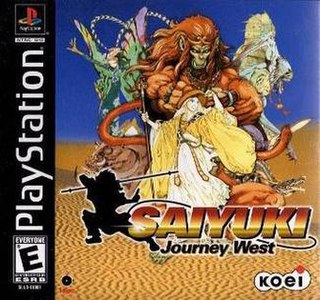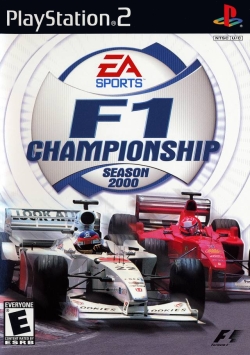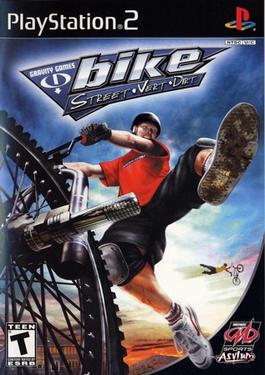
Summoner is an action role-playing game developed by Volition and published by THQ. It was released as a launch title for the PlayStation 2 in 2000, and was subsequently ported to Microsoft Windows and Mac OS the following year. In the game, the player plays the role of Joseph and can assemble a team of compatriots and summon powerful monsters. The game has a world map, involved storyline, and unique hybrid combat system involving real-time and turn-based mechanisms.

Batman: Vengeance is a 2001 action-adventure video game based on the fictional superhero of the same name. It was released for PlayStation 2, Game Boy Advance, GameCube, Xbox and Microsoft Windows. The game was developed and published by Ubi Soft in conjunction with Warner Bros. and DC Comics.

Sacrifice is a real-time strategy video game published by Interplay Entertainment in 2000 for Microsoft Windows platform. Developed by Shiny Entertainment, the game features elements of action and other genres. Players control wizards who fight each other with spells and summoned creatures. The game was ported to Mac OS 9.2 in 2001.

4x4 Evo 2, also known as 4x4 Evolution 2, is a racing video game developed by Terminal Reality for the PlayStation 2, Xbox, GameCube and Microsoft Windows. It is the sequel to 4x4 Evolution and features more trucks, and more racing tracks than the original game.

Star Wars: Starfighter is a 2001 action video game, developed and published by LucasArts, that takes place right before the Battle of Naboo. The player unites alongside three starfighter pilots and is allowed to take control of several different spacecraft to help stop the invasion that threatens Naboo.

Ooga Booga is an online multiplayer video game for the Dreamcast, focusing on the combat of "Kahunas" using thrown shrunken heads, riding animals, staffs, or using spells. The game received positive reviews from video game critics.

NHL 2002 is a video game released by EA Sports in 2001. It is the predecessor to NHL 2003. The game's cover man is Pittsburgh Penguins superstar and owner Mario Lemieux, who had just made a comeback after being retired for three and a half years. It was the first installment of the NHL series to be released on Xbox.

ESPN MLS ExtraTime is a sports video game released in 2001-2002 by Konami. It is available for PlayStation 2, Xbox, and GameCube. Clint Mathis is on the cover. The original ExtraTime was released for PS2 seven months after ESPN MLS GameNight on the PlayStation, with the GameCube and Xbox versions released in 2002 afterward as ESPN MLS ExtraTime 2002. MLS ExtraTime was the last in the series as the MLS sold its video game license to EA Sports' FIFA series.

Saiyuki: Journey West is a tactical role-playing video game released for the Sony PlayStation by Koei. It is based loosely on the Chinese novel Journey to the West.

Lotus Challenge is a racing game developed by Kuju Entertainment and published in 2001 for PlayStation 2 by Virgin Interactive. Versions followed for Windows, GameCube, Xbox, and mobile phones from different publishers.

NCAA Football 2003 is a video game of the sports genre released in 2002 by EA Tiburon. Its cover athlete is former Oregon Ducks quarterback Joey Harrington.

Stupid Invaders is an adventure video game developed by Xilam and published by Ubi Soft for Microsoft Windows in 2000 and Mac OS in 2001. A 2001 Dreamcast port was handled by Titanium Studios. The game is based on the animated television series, Space Goofs.

NASCAR Heat 2002, sometimes mislabeled as NASCAR Heat, is a NASCAR video game produced by Infogrames for the Xbox, PlayStation 2, and Game Boy Advance consoles. It is the successor to the 2000 game NASCAR Heat, and the predecessor to NASCAR: Dirt to Daytona. NASCAR Heat 2002 can have up to 24 (PS2) or 43 racers on one of 19 official NASCAR tracks, and the game was released in June 2001 for PlayStation 2. A port for the Xbox was released in November 2001. Developed by Crawfish Interactive, a distinct version for Game Boy Advance was released in May 2002.

Culdcept Second is a turn-based strategy video game for the Dreamcast released on 2001. It is the sequel to the Saturn title Culdcept. An enhanced version of the game, Culdcept Second Expansion, was released for the PlayStation 2 on September 26, 2002. The expansion was marketed in North America as Culdcept, and published by NEC Interchannel in December 2003.

F1 Championship Season 2000 is a racing video game based on the 2000 Formula One season, and was released by EA Sports for PlayStation, Microsoft Windows, PlayStation 2, Game Boy Color, and Mac OS X.

Gravity Games Bike: Street Vert Dirt is a sports video game developed and published by Midway for the PlayStation 2 and Xbox. It was released in North America on June 27, 2002 for the PlayStation 2 and on September 4, 2002 for the Xbox. It was the only game released under the Gravity Games license by Midway.

The Mummy, known in Japan as Hamunaptra: Ushinawareta Sabaku no Miyako, is a single-player video game for Game Boy Color, PlayStation and Microsoft Windows, based on the 1999 movie of the same name. It was published by Konami.

Le Mans 24 Hours is a video game released for the PlayStation, Game Boy Color, Dreamcast, PlayStation 2, and Microsoft Windows. The Dreamcast version was ported and published by Sega in Japan on 15 March 2001, while the PlayStation 2 version was ported and published by the same company on 13 June. Based on the famous 24 hours of Le Mans race in France, the player is invited to race the entire 24-hour endurance course or take part in a simpler arcade mode. The game also featured tracks such as Bugatti Circuit, Brno Circuit, Road Atlanta, Suzuka Circuit, Donington Park and Circuit de Catalunya, as well as a weather and night system.

ESPN NBA 2Night is a video game developed and published by Konami for Dreamcast and PlayStation 2 in 2000-2001. A sequel, ESPN NBA 2Night 2002, was released in 2002 for the PlayStation 2 and Xbox.

NCAA GameBreaker 2003 is a video game developed by 989 Sports and published by Sony Computer Entertainment America for PlayStation 2 in 2002.




















